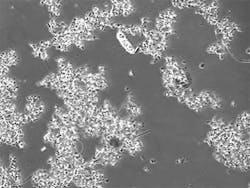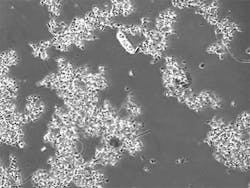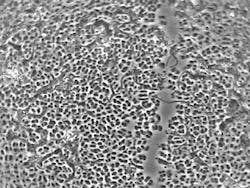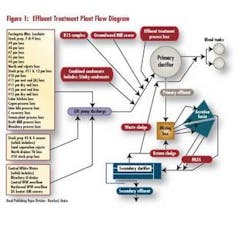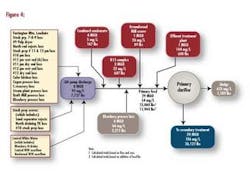Mass Balance Approach Successful in Controlling Bulking Sludge
By Steven E. Woodard and Stephen Fuller
The wastewater treatment plant (WWTP) at Mead Paper, Rumford, ME, historically struggled with sludge bulking episodes. Mill changes, including conversion to elemental chlorine-free (ECF) bleaching and alkaline papermaking, exacerbated the problem, and microscopic examinations revealed that organic acids were the primary cause of bulking.
The solution is an organic acid control program that results in a more stable, manageable secondary treatment system that can tolerate higher levels of filamentous organisms, while needing appreciably less sodium hypochlorite addition to the return activated sludge (RAS) for filament control.
The facility is an integrated bleached Kraft pulp and paper mill, 75 acres in western Maine, on the Androscoggin River. Total production is roughly 1700 T/D market pulp and finished paper. Products are coated grades such as magazine, catalog, insert and commercial printing papers and market pulp. The mill operates four coated paper machines and one pulp dryer, along with a hardwood and softwood Kraft pulp mill and bleach plant and a groundwood mill. The mill also includes power generation from a hydro facility (40 MW), co-generation plant (100 MW), and two other power boilers (12 MW). Sludge, wood waste, and tire derived fuel is burned in the co-gen facility, as well as oil and coal.
Wastewater generated by the mill averages 30 mgd. The wastewater is treated using coarse screens, primary sedimentation, and a complete mix activated sludge system. Primary treatment consists of a single, 220-foot-diameter clarifier. Primary effluent flows by gravity to two aeration basins, operated in parallel. The basins provide a total volume of 8.85 million gallons and have a liquid depth of 14 feet. Coarse bubble diffused air supplies oxygen to the aeration basins. There are three rectangular secondary clarifiers, with a total volume of 6.35 million gallons and a side water depth of 15 feet. Primary and secondary sludges generated by the WWTP are combined and dewatered on gravity belt thickeners and screw presses.
The WWTP has several physical limitations. Since there is only one primary clarifier, much of the maintenance can only be performed during periodic mill shutdowns, particularly cold outages when there is very little wastewater flow. The aeration basins are marginally sized for the average primary effluent biochemical oxygen demand (BOD) loading of 70,000 lb/day. A mixed liquor suspended solids (MLSS) concentration of 4,500 to 5,500 mg/l is needed to maintain a suitable F/M to prevent overgrowth of 1701, a filamentous bacteria caused by high F/M, low dissolved oxygen (DO) conditions. The diffused aeration system is also marginally sized, often resulting in mixed liquor DO concentrations of less than 1.0 mg/l.
The secondary clarifiers are undersized with respect to solids loading rate, which averages 1.4 lb/ft2-hr. This means that the secondary clarifiers are being loaded 75% higher than design guidelines recommend for pulp and paper mill secondary clarifiers. This is mostly due to the relatively high mixed liquor concentrations that must be carried to discourage the overgrowth of 1701. The secondaries have also had problems with hydraulic short-circuiting currents and poor flow split between the clarifiers.
Historical Treatment Challenges
The combination of factors described above, coupled with the inherent variability associated with pulp and paper mill wastewater loadings, makes this a challenging plant to operate. The WWTP has little buffering capacity, due to the marginally sized aeration basins, secondary clarifiers and aeration system. As a result, operating conditions can change rapidly, and operators must react quickly and maintain a close watch on a number of operating parameters.
The mill also has tightened up solids losses over the last several years, leading to longer solids retention times in the primary sludge blanket, since the operating blanket depth has remained roughly the same. Primary clarifier sludge blankets provide a favorable environment for the generation of organic acids.
The combination of mill changes described above coincided with a substantial increase in the predominance of globular zooglea in the WWTP mixed liquor. Increasing globular zooglea concentrations came to a head in the fall of 1999. This shift in microbial population caused the secondary clarifiers to become intolerant to even moderate levels of filamentous bacteria. The relatively large, gelatinous floc particles (up to 700 microns in diameter) that resulted were uncharacteristically susceptible to short-circuiting currents in the secondary clarifiers.
Secondary clarifier performance suffered and SVI levels had to be controlled below 70 ml/g in order to maintain control over secondary sludge blankets and solids loss. The laboratory settleometer, which had previously provided a good indication of how well solids would settle in the secondaries, was no longer reliable. The floc was so "light and fluffy" that even mild hydraulic currents resulted in floc carryover.
It soon became necessary for plant operators to add substantial quantities of sodium hypochlorite. As much as 11,000 gallons per day were needed to keep the SVI below 70 ml/g. The floc quality eventually deteriorated to the point where bleach no longer solved the problem. The mill was running out of options. Polymer addition helped. However a point was reached where increasing the dose no longer had a beneficial effect.
Project Objectives
Since the mill's traditional methods of controlling sludge bulking were no longer successful, the focus of the troubleshooting effort turned to the root cause of the problem: excessive organic acid loadings on the biological treatment system. More specifically, the following two project objectives were identified:
1. Determine the predominant sources of organic acids by applying a mass balance approach to the WWTP and its contributing streams.
2. Reduce the organic acid loadings to the biological treatment system by implementing appropriate modifications and/or control measures.
Mass Balance Approach
The project team decided to use a mass balance approach to determine the chief sources of organic acid contribution to the wastewater. Mill personnel began collecting samples throughout the mill and WWTP for routine organic acid analysis. Comparing pounds of acetic acid in the primary feed, calculated by two methods, tested the validity of the mass balance. Method one was calculated based on flow and concentration (13,060 lbs.). Method two was calculated as the sum of the individual feed streams in lbs. (11,944 lbs.). The results were well within sampling and testing error. The mass balance effort was further simplified by focusing solely on acetic acid, since the contributions of other organic acids were negligible in comparison.
It soon became apparent that the majority of the acetic acid loading was being generated in the primary clarifier, and was primarily formed in the sludge blanket. The mass balance shows that on that day approximately 12,500 pounds per day of organic acids entered the clarifier, while more than 26,000 pounds left the unit. Thus, approximately 13,500 pounds per day were generated in the clarifier. This was found, through extensive testing, to be about typical of this plant. As explained above, this is not surprising given the:
1. Relatively large size of the primary clarifier, 220 feet in diameter;
2. Increasing trend in solids residence time in the clarifier of approximately two days;
3. Abundance of starch and other readily biodegradable substrates in the sludge blanket;
4. Relatively warm wastewater temperatures of 115 deg F.;
5.
These conditions provided an ideal environment for the growth of anaerobic organisms, which degrade the starch and other substrates into organic acids. Over time it also became apparent that the acetic acid content of the sludge was the most representative, "composite" indicator of organic acid generation in the primary clarifier. Primary effluent acetic acid concentrations tended to fluctuate too much to provide a reliable indication.
Organic Acid Control Program
Given the results of the acetic acid mass balance work, an organic acid control program was developed to focus on the primary clarifier.
The first organic acid control step was actually implemented in the fall of 1997 (two years before the majority of the troubleshooting work began). Prior to then, secondary sludge was being wasted to the primary clarifier to be co-settled with primary sludge. The practice of co-settling provided a concentrated seed of "hungry" microorganisms to feed on the starch in the primary sludge blanket, which greatly exacerbated the formation of organic acids, hydrogen sulfide and other products of anaerobic decomposition. Once this was realized, plant operators began wasting secondary sludge directly to the sludge blend tanks.
It is likely that, had this change not been implemented earlier, the severe secondary settling problems would have manifested themselves much sooner than the fall of 1999, and in a more pronounced way. In effect, discontinuing the practice of co-settling became a pre-emptive strike that enhanced secondary treatment performance. Preliminary organic acid analyses showed that it caused the organic acid loading to the biological treatment system to decrease, although the data set was not comprehensive enough to accurately quantify the reduction. It also greatly reduced odor generation and corrosion in the primary clarifier, providing a safer, more comfortable work environment for the operators.
Next, the team sought to further reduce the microbial "seeding" of the primary clarifier by re-routing the gravity belt thickener and screw press filtrate from the primary influent to the primary effluent. A trial, however, produced no appreciable benefit, and even had an adverse effect on the activated sludge system because the additional suspended solids loading increased the MLSS concentration to the point where it became uncontrollable. The relatively small size of the secondary treatment system is likely to have been a factor in the loss of MLSS control.
A second attempt was then made at bypassing the sludge press filtrate around the primary clarifier. This involved a spare blend tank to settle solids from the filtrate. The clarifier blend tank overflow was sent to the aeration basin and the settled solids were returned to the sludge dewatering operation. This method successfully removed filtrate from the primary clarifier, but the resultant decrease in organic acid levels was disappointing.
A final trial on the sludge press filtrate involved bleaching the filtrate before returning it to the primary clarifier. The idea was to "inactivate" the microbial seed using a strong oxidant. As with the other filtrate trials, the results showed no appreciable reduction in organic acid generation.
The primary clarifier inlet baffles were replaced in an attempt to minimize the solids residence time by improving hydraulic efficiency. The team hoped that by dropping the solids out closer to the center of the clarifier, they would spend less time in the clarifier and generate fewer organic acids. Although replacing these baffles did improved hydraulic efficiency and reduce the solids residence time, it did not appear to have a measurable impact on organic acid generation.
The study focused next on minimizing the primary sludge blanket depth, without sacrificing the ability to provide a consistent feed to the screw presses. Although this idea had merit, plant operators found that they were not able to maintain the sludge blanket at levels low enough to appreciably reduce the generation of organic acids.
In another attempt to focus directly on the primary sludge blanket, a trial was performed to evaluate the impact of injecting sodium hypochlorite directly into the sludge. The theory behind this approach was to minimize organic acid generation by controlling the oxidation-reduction potential (ORP) in the sludge blanket. Since anaerobic bacteria require a low-ORP environment to thrive, the team hypothesized that adding bleach to the sludge would raise the ORP and inhibit the formation of organic acids.
This trial involved installing a temporary sludge recycle line using one of the primary sludge pumps and a minor piping modification. This system, which is still in place and functioning, recycles sludge from the bottom of the clarifier back to the primary influent. In the process, sodium hypochlorite is injected into the sludge recycle line. The results of this trial have been impressive, as it has significantly reduced the generation of organic acids in the primary clarifier. The mill has seen an associated reduction in the globular zooglea content of the mixed liquor, which had become the primary cause of sludge bulking in the secondaries.
Since the trial began May 7, 2001, the stability of the activated sludge system has greatly improved. The WWTP is now able to tolerate SVIs in the 140 ml/g range, signaling a return to historical operating conditions. Average BOD removal has increased from 93% to 95%, which is likely due to decreased frequency of sodium hypochlorite use on the RAS.
Further evidence of the importance of controlling conditions in the primary sludge blanket came during the mill's cold outage in September 2001. During this outage, the primary clarifier was drained, cleaned and inspected. The activated sludge system ran extremely well during the six weeks that followed. But operating conditions once again deteriorated as the sludge blanket matured and organic acid levels began to climb. It was noted during the cold outage that the sludge rakes were missing the bottom strip of metal which, when the clarifier was relatively new, helped keep the bottom of the clarifier clean by providing a "squeegee" effect. New material has been ordered to replace the strips.
Conclusion
A number of changes have occurred at Mead Paper's Rumford mill over the last few years. One or more of these changes have caused the organic acid levels to increase in the primary effluent wastewater. In the fall of 1999, elevated organic acid levels caused the microbiology to shift to the point where it became dominated by globular zooglea. This population shift made the WWTP extremely difficult to operate, because SVIs had to be maintained below 70 ml/g in order to maintain control over the secondary sludge blankets.
The following specific conclusions were developed as a result of ongoing troubleshooting activities at the WWTP over the last two years.
1. Globular zooglea is the predominant cause of the recent, problematic sludge bulking conditions experienced at the WWTP.
2. The shift in microbiology toward globular zooglea was caused by increasing organic acid loadings on the activated sludge system.
3. The primary clarifier is the largest single contributor of organic acids to the biological treatment system.
4. Acetic acid is the predominant organic acid in the primary clarifier effluent.
5. Tracking acetic acid levels in the primary sludge blanket provides an effective tool for indicating organic acid generation in the primary clarifier.
6. Recycling and bleaching the primary sludge has proven to be an effective means of controlling organic acid generation in the primary clarifier.
7. The result has been a much more stable, controllable biological treatment system, which is once again able to operate at reasonable SVI levels.
About the Authors:
Steve Woodard, Vice President, Woodard & Curran, Portland, ME, is a licensed professional engineer. He earned his doctorate in civil and environmental engineering at Purdue University, West Lafayette, IN, and has 15 years of experience in industrial and municipal wastewater treatment. Woodard can be reached at [email protected]. Steve Fuller, also a licensed professional engineer, has been Effluent Treatment Plant superintendent at Mead's Rumford, ME, facility for seven years, and has 30 years of experience in wastewater treatment.
